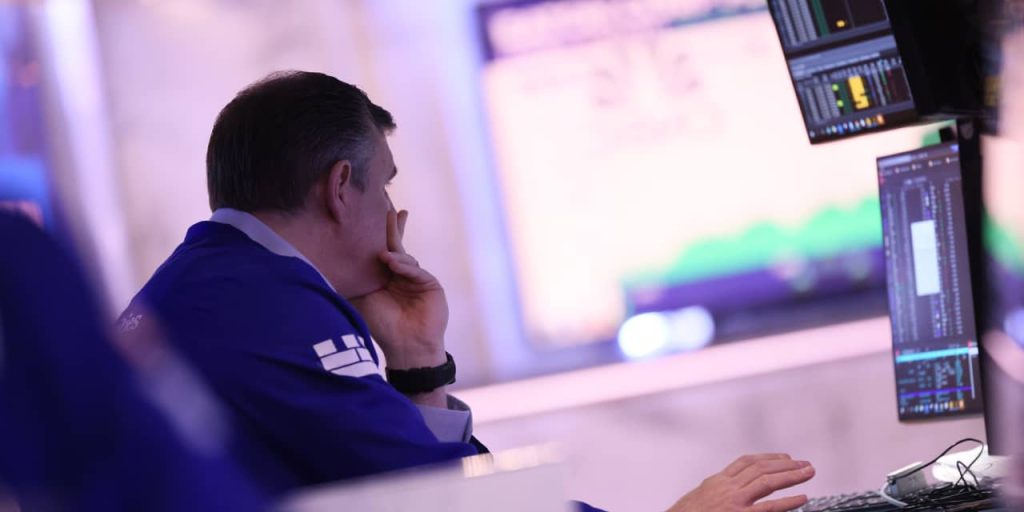The S&P 500 is up 25% since its October lows. Traders work on the floor of the New York Stock Exchange.
Michael M. Santiago/Getty Images
In the midst of a major rally for U.S. stocks, some investors may be wondering if it’s too much of a good thing.
The
S&P 500
has had an extraordinary few months, any way you slice it. The index is up more than 25% from its October lows, and as Deutsche Bank Macro Strategist Henry Allen writes, “The current rally is almost unprecedented.”
The index is now up 15 out of the past 17 weeks, a feat that’s only happened one other time in the past half-century, in 1989. If it notches yet another gain this week, for 16 out of 18, it would be the first time that’s happened since 1971.
It’s no secret why optimism has soared. Since the October lows, inflation has continued to cool even as economic data remains upbeat. That has allowed the Federal Reserve to get more dovish, leading to hopes of interest rate cuts to come. Treasury yields, which had weighed on equities, have dropped.
However, is that really enough to warrant stocks’ surge?
“If we look at the facts, I cannot help but feel as though this relentless rally has gone far beyond either actual improvement in the fundamentals and reasonable expectations of continued improvement,” writes Sevens Report Founder and President Tom Essaye.
Although market expectation for interest-rate cuts in 2024 have come down from seven at the end of 2023 to four currently, no rate cuts have happened during the S&P 500’s meteoric rise. Inflation has drifted lower, but isn’t at the Fed’s target.
Such a massive rally—largely resting on enthusiasm about artificial intelligence and a few big tech stocks—has led to concerns that we might be in a tech stock bubble akin to the dot-com bubble at the turn of the century.
On the other hand,
Nvidia’s
revenue and profits are quite real and they are growing at an astonishing rate. It results last week, the latest in a series of blowout quarters, is “Unprecedented. And it speaks to the power and durability of this A.I. craze,” notes Rosenberg Research President Dave Rosenberg. “Nvidia’s stellar results and positive guidance hammered home the point of how generative AI is proving to be transformative in every respect, and in ways most of us still can’t comprehend.”
Rosenberg notes that the company won’t keep its near-monopoly position forever, but that it’s far ahead for the moment, and its share price doesn’t seem particularly expensive, given the company’s explosive growth. Few companies of its size have been able to maintain such growth, Rosenberg writes, but if AI bulls are right, it could continue to defeat the odds. “We are basically down to the Magnificent One—the company clearly is in a league of itself.”
Deutsche’s Allen also sees the rally’s narrow breadth as a potential weak spot for the index. Last year the S&P 500, which is weighted by the market valuations of companies, rose 24.2% but would have been up just 11.6% on an equal-weighted basis. That made 2023 the first time since 1998 (in the midst of the dot-com fervor) that the S&P 500 outpaced its equal-weighted version by more than 10 percentage points. Year to date, the index is up 6.7% versus just 2.5% for the equal-weighted index.
And while Nvidia’s valuation may be easy to justify, the S&P 500 as a whole looks pricey: It is now trading at almost 22 times forward earnings, as expectations for full-year earnings per share for the index have come down from $245 to $250 in October to $243 today.
As Essaye points out, a price-to-earnings ratio around that level was “previously only reserved for periods of quantitative easing and 0% rates, not quantitative tightening and 5.37% fed funds.”
There’s also the potential for blowback against AI among the general public, and calls for more regulation.
Fred Havemeyer, head of US AI & Software Research at Macquarie, thinks “we will likely see high-profile generative AI failures in 2024, particularly as AI earns more of the public’s attention throughout the election cycle.”
Of course, skeptics haven’t been right yet. The average year-end price target for the S&P 500 as tracked by FactSet, of 5,556, implies more than 9% upside left for the year. RBC Capital Markets has also argued that the index looks capable of supporting a valuation of 23.55 times.
There is also the possibility for a near-term pullback before gains continue.
It’s hard to say that the AI boom is truly nearing a top. But it’s worth remembering ChatGPT doesn’t have all the answers—yet.
Write to Teresa Rivas at [email protected]
Read the full article here
